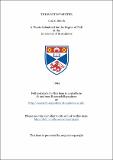Files in this item
The root in winter
Item metadata
| dc.contributor.advisor | Crawford, R. M. M. | |
| dc.contributor.author | Smith, Lisa C. | |
| dc.coverage.spatial | 252 p. | en_US |
| dc.date.accessioned | 2018-06-20T15:10:25Z | |
| dc.date.available | 2018-06-20T15:10:25Z | |
| dc.date.issued | 1994 | |
| dc.identifier.uri | https://hdl.handle.net/10023/14359 | |
| dc.description.abstract | Factors affecting the survival of over-wintering tree roots during waterlogging were investigated. Die-back of roots covered by high Winter water tables results in shallow rooted trees susceptible to wind-throw. Such is the scale of the problem in Britain, this research is considered to be of practical relevance. Sitka spruce (Picea sitchensis (Bong.) Carr.) and Lodgepole pine (Pinus contorta Douglas ex Loudon) were chosen, being the most predominant species planted and showing differing susceptibility to flooding. Sitka spruce is considered flood-intolerant (Crawford 1982) and Lodgepole pine highly-tolerant (Minore 1968). In both species, waterlogging the whole root system for 3 months severely reduced the carbohydrate content of the distal 15cm root, reflecting almost total depletion of starch reserve and varying degrees of glucose depletion. In Sitka spruce, depletion depended on the date of flood-initiation, being most severe after flooding from October when root respiration rate was higher, rather than November as the roots became dormant. Flooding injury was reflected in decreased tri-phenyl tetrazolium chloride reduction and loss of respiratory capacity. Greater loss of aerobic (as compared to anaerobic) respiration capacity after flooding suggested damage to the aerobic pathway, either directly through anoxia or indirectly due to depletion of sugars important in cell maintenance. Injury appeared to be greater when respiratory activity at flood-initiation was high. Aeration from stem lenticels ameliorated flood-injury and carbohydrate depletion in Lodgepole pine, although the roots appeared to have no metabolic adaptation to anoxia. Increased soil temperature during Winter flooding increased carbohydrate depletion in the distal root and reduced viability relative to seedlings flooded at ambient temperature. Carbohydrate depletion during cold storage and its effect on survival of soil waterlogging at out-planting was determined in Sitka spruce. Cold storage leads to increased root growth and slightly superior flood-tolerance when compared to nursery over-wintered seedlings, presumably due to the more dormant state of stored seedlings. | en_US |
| dc.language.iso | en | en_US |
| dc.publisher | University of St Andrews | |
| dc.subject.lcc | QK756.S6 | en |
| dc.subject.lcsh | Plants—Effect of cold on | en |
| dc.title | The root in winter | en_US |
| dc.type | Thesis | en_US |
| dc.contributor.sponsor | Natural Environment Research Council (NERC) | en_US |
| dc.type.qualificationlevel | Doctoral | en_US |
| dc.type.qualificationname | PhD Doctor of Philosophy | en_US |
| dc.publisher.institution | The University of St Andrews | en_US |
This item appears in the following Collection(s)
Items in the St Andrews Research Repository are protected by copyright, with all rights reserved, unless otherwise indicated.

